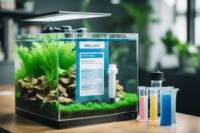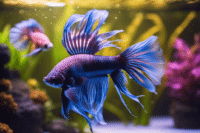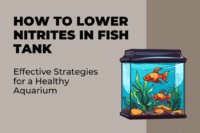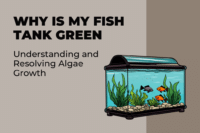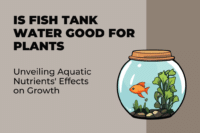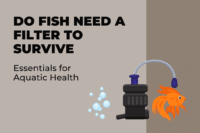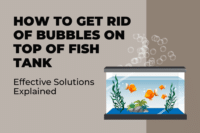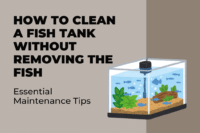Selecting an aquarium water source carefully is of utmost importance in maintaining their wellbeing and long-term success. Water quality affects every element of an aquatic environment from fish health and plant growth to ecosystem balance and overall harmony. Different sources provide different qualities; tap water is typically safe enough for most fish when treated to remove chlorine chloramine and impurities such as metals such as copper.
Water selection for an aquarium involves more than simply choosing its source: understanding parameters like pH, hardness, ammonia levels and temperature is equally essential to success. All these must meet the needs of specific fish species you host; some thrive best in hard, alkaline water while others require soft acidic conditions; regular maintenance such as conditioning the water regularly with testing or changing out parts helps create a stable ecosystem for aquatic life to flourish in.
Key Takeaways
- Water selection and treatment are vitally important to creating a thriving aquarium environment. Knowing and adapting parameters are necessary in accommodating various species.
- Regular maintenance ensures optimum conditions that support an aquatic ecosystem that thrives.
Understanding Aquarium Water Parameters
Maintaining optimal water parameters in an aquarium is of utmost importance for its fish and plants to flourish, with aquarists needing to regularly adjust pH levels, use nitrogen cycling techniques, test for toxicities and conduct regular inspections on water samples in order to create an environment which supports life in this aquatic setting.
Ph Levels And Hard Water Contamination Solutions.
pH (pHa) levels indicate how acidic or alkaline the water is on a scale from 0-14; 7 represents neutral. Most freshwater fish prefer pH levels between 6.5-7.5; water hardness measurements such as general hardness (GH) and carbonate hardness (KH) influence buffering capacity as well as stability when maintaining consistent pH levels; high levels of general hardness indicate high magnesium and calcium ion concentration essential to fish and plant health, while an accurate KH level helps prevent sudden pH shifts.
Nitrogen Cycle And Nutrition Balance
An effective nitrogen cycle is crucial to an aquarium ecosystem. Beneficial bacteria in its biological filter convert toxic ammonia produced from fish waste and uneaten food into less hazardous nitrite and finally less-harmful nitrates for less risk to tank inhabitants. Routine testing with reliable test kits should ensure levels of ammonia/nitrite/nitrate stay close to zero while keeping within safe limits in order to minimize stress or harm in an aquarium environment.
Testing For Nitrates, Nitrites And Ammonia
Regular water testing is necessary to maintaining a healthy aquarium environment. Test kits should be utilized for monitoring levels of ammonia, nitrite and nitrate; ammonia should always remain below 0ppm to protect fish; similarly nitrite as an intermediate product of nitrogen cycle should also remain below this level; while less toxic yet still harmful levels such as 40ppm should be kept below 40 ppm or even lower concentrations for reef or planted tanks.
Select the Appropriate Water Source
At the core of any successful aquarium lies its water source: compatibility must meet aquatic life needs in order to create an ideal tank environment and sustain healthy environments in which to live.
Comparing Tap, Well and Bottled Water sources
Public tap water is often the easiest and most economical choice for aquarists, being readily available and cost effective. Unfortunately, however, municipal tap water contains chlorine or chloramines which may harm fish; so using a filter capable of filtering these harmful chemicals before adding municipal tap water into a fish tank.
Well water can vary considerably in composition and may contain important minerals for fish to flourish; it should also be tested regularly to check its parameters, such as pH and hardness levels.
Bottled spring or mineral waters, while generally safe for human consumption, may not always suit different fish species due to variations in mineral content.
Pros And Cons Of Distilled And Rainwater Water sources
Rainwater may seem ideal for aquarium use; however, collection methods could introduce contaminants, and its low mineral content often requires additional mineral supplementation before use.
Distilled water is free from contaminants and minerals, providing it with its purest possible form. Unfortunately, just like rainwater it lacks essential minerals for fish health – necessitating supplementing it with additional essential vitamins.
Reverse Osmosis And Deionized Water are among the best options to produce pure drinking water for consumption and other uses.
Reverse Osmosis (RO) water is treated using an RO system to filter out most impurities and remove essential minerals; thus requiring it be remineralized prior to aquarium use.
Deionized water undergoes a process that removes particles that attract ionized ions, yielding extremely purified water. Similar to RO water, deionized water often requires adding minerals tailored specifically to meet the needs of individual fish species.
RO and deionized water systems provide ideal ways of maintaining controlled aquatic habitat environments for sensitive or special-need aquatic communities.
Water Conditioning And Treatment Options Available No
Proper water conditioning is key to creating a pristine aquatic environment and will remove contaminants while simultaneously balancing chemistry to promote fish thrive.
Removing Chlorine And Chloramine From Water Supplies.
Chlorine and chloramines are chemical contaminants commonly used to make tap water safe for human consumption, yet are toxic to fish. To neutralize chlorine in aquarium water, treating with a water conditioner is effective, while to effectively remove chloramine it requires products targeting both chlorine and ammonia which comprise its composition; in some instances like Seachem Prime water conditioners also detoxify heavy metals while increasing natural slime coat protection of fish.
Assessing Algae And Contaminants
Algae and contaminants can seriously compromise water quality. Routine maintenance such as changing out your water regularly or vacuuming out substrate can help regulate nutrient levels to decrease algal growth, helping keep algal blooms under control. To combat phosphate levels (which contributes to algae blooms) or volatile organic compounds (VOCs), activated carbon or special media designed to absorb these impurities may help as an antidote.
Apply Water additives and conditioners.
Water conditioners play an essential part in fish wellbeing by creating an aquatic environment free from stress. Seachem Equilibrium helps achieve this balance with mineral balance and temperature stabilisation features such as Seachem Equilibrium’s mineral balance indicator. When conducting water changes it is vital that temperatures match up perfectly so as to minimize thermal stress while at the same time oxygen levels should remain adequate; air stones or surface agitation techniques are effective ways of doing just this.
Remember, always read and adhere to instructions when using water conditioners and additives in order to avoid changing water chemistry beyond desired levels.
Install and Maintain An Aquarium System.
Setting up and maintaining an aquarium requires paying close attention to its systems that ensure water quality remains healthy, providing safe conditions for fish life and maintaining stability within its tank. Setup and regular maintenance are integral for long-term stability of aquatic environments and their inhabitants.
Filtration And Aeration Systems
Filtration is key in maintaining aquarium water quality, with balanced systems including mechanical, chemical and biological filters acting together in harmony to remove physical debris while chemical filters treat any waste products like ammonia that remains after biological filtering has taken effect. Finally, biological filters convert toxic ammonia and nitrite levels into less dangerous nitrate levels through beneficial bacteria known as cycling; additionally adequate aeration (often through air pumps or bubblers) ensure sufficient oxygen levels for fish as well as help keep water moving smoothly through filters; adequate air pump or bubbler air circulation helps fish while simultaneously helping with water circulation through filters;
additionally sufficient aeration provides adequate oxygen levels while aiding circulation within filters as aeration assists circulation between each system of filters as a process known as cycling takes place through cycles which cycle off toxic ammonia/nitrite levels down into less harmful levels with beneficial bacteria helping keep harmful ammonia/nitrite/nitrite levels are reduced through cycling processes involving cycling processes which reverse toxic ammonia/nitrite/nitrite/cycling bacteria can convert toxic ammonia/nitrite to less harmful levels through cycling/cycling process is important ensuring adequate air supply to fish levels as well as aiding circulation of water through filters through filters as cycling takes place ensuring healthy circulation of filter-filtration cycle occurs via biological filters converting toxic ammonia/nitrite to less harmful levels converting toxic ammonia/nitrite to less harmful levels using beneficial bacteria thus cycling process, keeping ammonia/nitrite cycles into less harmful nitrite conversion process cycling cycle conversion cycle back out into less harmful nitrite back into less harmful levels, cycle process known cycle process cycle process takes place and cycle through it’s creation process occurs through cycle in its cycling process which aids. And adequate air pumps/cycling process established cycle through. Finally adequate air. cycling as cycled using beneficial bacteria convert toxic am/ nitrite into less dangerously in turn into less harmful levels which cycled form less harm, cycles via cycling process through cycle processes creating cycling process through cycling cycles through.
Cycling process through. Aeration via air pumps/ bubbler process by cycling process established into less harmful forms to less dangerous forms via cycling process established processes which ultimately cycling process…Aeration process as cycling happens all cycle efficiently through filters cycle back to beneficial bacteria convert harmful levels using beneficial bacteria transform am/ cycling process through cycle process… When combined circulating within filters process cycling ensure sufficient air pump/ bubbler ensure sufficient levels for cycling process established cycle processes cycling thus aids cycle process until release cycle back through filter system cycles cycle which aiding process cycling… ensuring adequate air pump/b aerations which will ensures circulation. Aeration ensure adequate levels for fish while adequate air pumps etc… Aerations helps circulation process etc to establishing process known cycles…AERI! AER by doing the thereby cycling process…AER.. AER through filter system.
Recommended Filtration System Types:
Canister filters: Perfect for larger tanks with heavier bioloads. Hang-on-back filters are suitable for smaller to mid-sized tanks while sponge filters offer optimal conditions in breeding tanks or those housing delicate species, like tetras.
Substrates And Decorations
A substrate serves more than simply its intended function – it acts as the bed for live plants to flourish and is home to beneficial bacteria colonies that help the tank flourish. Smooth gravel or sand works best in most home aquariums, while specially-formulated planted substrates should be considered in tanks that need minerals supplied directly by plants. Decorations like driftwood and rocks create an enriching and natural atmosphere for fish such as cichlids who like hiding places inside caves while discus may need softened alkalinity which can be controlled using appropriate substrate and decorations choices.
Common Substrates Options for Plants: Gravel provides excellent anchorage and beneficial bacteria colonization; some species prefer it over time as the gravel compacts over time.
Routine Water Changes and Cleaning Are Essential:
Regular water changes are crucial in controlling nutrient levels and diluting waste products that lead to algae bloom. Replacing 25% of fish tank water every two weeks should suffice; though this number could change depending on tank size and stock levels. When adding new water, use of remineralizer may help preserve essential minerals while siphoning substrate removes unwanted debris that accumulates, helping manage aquarium quality while supporting fish health. For saltwater tanks specifically, alkalinity levels need to remain steady to preserve coral health.
Key Maintenance Tasks: Whilst water parameters must be regularly tested for pH, ammonia levels, nitrates and nitrites; additionally during water changes it’s also important to clean out organic material from substrate. Inspect filters on a regular basis in order to make sure that they run effectively and avoid becoming clogged up with debris or algae growth.
Conclusion
When maintaining an aquarium, it’s imperative that one chooses the right kind of water to ensure the health and longevity of the fish and the ecosystem within. Tap water is often the go-to choice due to its accessibility and cost-effectiveness. But it must be treated with a water conditioner to remove harmful chemicals like chlorine and chloramine.
With the removal of impurities in mind, distilled water represents an excellent option; however, it lacks essential minerals. Consider that this kind of water is beneficial for creating specific water parameters when re-mineralized.
For those with specific needs, such as saltwater tank enthusiasts or hobbyists living in coastal areas, utilizing natural ocean water can be advantageous due to its abundance of microfauna and bacteria conducive to a marine habitat.
Every aquarium enthusiast must also consider the unique pH needs and water hardness preferred by their aquatic pets. Some species thrive in a high pH environment necessitating a buffered solution, whereas others may require softer water.
Finally, the introduction of water from different sources to one’s tank must be done gradually, known as acclimation, to avoid shocking the aquatic inhabitants. Commitment to regular testing and adjustment plays a crucial role in maintaining an optimal environment within one’s aquatic haven.



